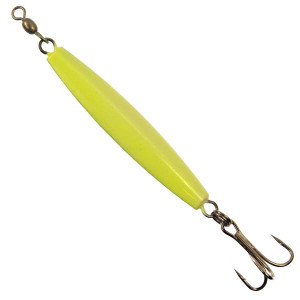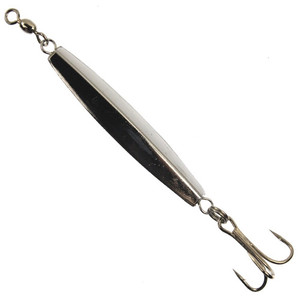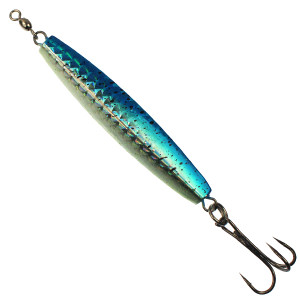
Diamond Jigs - UV Chilipepper
- New Look, Same Results -
Our new Pitbull Tackle UV Chilipepper Diamond Jigs are a combination of our popular UV Red and UV Orange Diamond Jigs which were an incredibly popular lure for rockfishing along the West Coast. Now offered in a jig that combines both UV colors, this jig was designed for catching big rockfish. The bright UV-Enhanced paint allows for better visibility in deeper water and the black splatter will help break up the bright pattern to make the jig appear more life-like to hungry fish. This will be a great choice for targetting Vermillion especially in deeper water. Diamond Jigs themselves are some of the most diverse lures, having successfully caught countless species of fish for years all over the world. The Pitbull Tackle Diamond Jig is made up of a slender piece of metal with a treble hook attached via split ring. Many anglers like to add their own upgraded hook regardless of what comes stock on these types of jigs, but these jigs are ready to fish right out of the package. The top of the jig where the angler ties his main line to has a barrel swivel attached to help the jig spin freely and avoid line twist. Smaller sizes are great for casting, jigging and trolling. The larger sizes are ideal for jigging deep or fishing in heavy current. In terms of profile, artificial lures don’t get much simpler than the Pitbull Tackle Diamond Jig.
Check out our full selection of Custom Lead Jigs!
How To Fish
Diamond Jigs are effective for boat anglers and shore anglers alike. Adjusting the hook for the species you are fishing can be a crucial step in helping secure your catch. A treble hook is an excellent all-around hook, and in most occasions is the ideal hook to keep fish pinned. When casting and retrieving in the sand or surf zones, a single hook is usually desired as this creates less drag in the sand and snags far less. Adding a piece of colored surgical tubing to the hook is also a great way to mimic sand eels in the surf zone. A single hook is also preferred when fishing for various species of tuna, as a heavy-duty hook can be easily swapped on the split ring.
Deep Water Jigging: Diamond Jigs sink quickly to the bottom with their streamlined design. Due to their fast sink rates, they are usually a favorite for fishing deep rock piles or structure, as the bait takes much less time to sink to the strike zone than other lures. When fishing deep water, jigging is the most common effective strategy. Begin by free spooling the bait down to the bottom until the line has slacked out. Raise the rod tip up and let the jig free fall back down to the bottom. It is essential to let the jig flutter and fall on slack line, as slowing its descent too much will often make the jig fall back down to the bottom vertically with little to no action. The jig will rise and fall with erratic action, banging and knocking into any structure on the bottom. The UV and Glow enhanced visibility paired with the noise and commotion of the jig will entice hungry predators from all over. In fast drifts, hitting bottom and reeling the bait a few feet up before beginning to jig the lure can also be an effective strategy for staying out of snags. The drift and movement of the boat will give a surprising amount of action to the lure. Whenever reeling the jig up and back to the boat, be mindful of bites as often times hungry fish will strike the lure up off of the bottom.
Shallow Water Techniques: When fishing shallower water, typically a yo-yo or a rip-stop retrieve is used. Cast out and let the jig flutter to the bottom. Ripping the jig up with the rod tip will cause erratic action, and the jig will flutter back down to the bottom. This style retrieve mixed with current not only gives the lure more action but it lets the angler cover a lot of water. A second strategy in shallow water is a cast and retrieve. This is usually done with light 2oz or 4oz jigs. Diamond Jigs have an enticing side to side swimming action which is not very well known to many anglers. Make a test cast to see which retrieve speed allows for the right swimming action. Reeling too slow or too fast can sometimes cause the lure to swim incorrectly or not at all. Once you have found the correct speed, cast out and let the lure do the work for you.
![]() WARNING: This product can expose you to chemicals including Di(2-ethylhexyl)phthalate (DHEP) and lead, which are known to the State of California to cause cancer, and birth defects or other reproductive harm. For more information, go to www.P65Warnings.ca.gov
WARNING: This product can expose you to chemicals including Di(2-ethylhexyl)phthalate (DHEP) and lead, which are known to the State of California to cause cancer, and birth defects or other reproductive harm. For more information, go to www.P65Warnings.ca.gov






